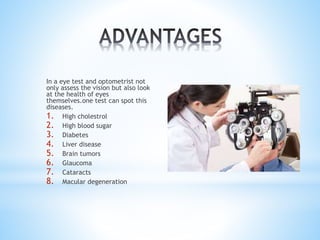The Function of Advanced Diagnostic Devices in Identifying Eye Disorders
In the realm of ophthalmology, the utilization of innovative analysis tools has changed the early recognition and management of numerous eye disorders. As the demand for accurate and prompt diagnoses continues to expand, the combination of innovative tools like optical comprehensibility tomography and visual area testing has ended up being crucial in the world of eye treatment.
Importance of Early Diagnosis
Very early diagnosis plays a critical role in the effective administration and treatment of eye disorders. Prompt identification of eye problems is crucial as it enables punctual treatment, potentially preventing more progression of the disease and decreasing long-lasting issues. By spotting eye conditions at a beginning, healthcare suppliers can use ideal treatment plans customized to the certain condition, ultimately causing far better outcomes for individuals. Very early diagnosis enables people to gain access to essential assistance solutions and resources earlier, improving their general top quality of life.

Technology for Detecting Glaucoma
Sophisticated analysis technologies play an important function in the early detection and surveillance of glaucoma, a leading reason for permanent blindness worldwide. One such innovation is optical coherence tomography (OCT), which offers detailed cross-sectional images of the retina, enabling the measurement of retinal nerve fiber layer density. This measurement is crucial in examining damages triggered by glaucoma. Another advanced tool is visual area testing, which maps the sensitivity of a person's aesthetic area, helping to spot any type of areas of vision loss feature of glaucoma. Furthermore, tonometry is utilized to gauge intraocular stress, a major danger factor for glaucoma. This examination is critical as elevated intraocular pressure can lead to optic nerve damages. Moreover, newer technologies like the use of expert system formulas in analyzing imaging data are revealing encouraging outcomes in the very early detection of glaucoma. These innovative diagnostic tools make it possible for eye doctors to diagnose glaucoma in its early stages, enabling prompt intervention and much better management of the condition to stop vision loss.
Role of Optical Comprehensibility Tomography

OCT's capacity to quantify retinal nerve fiber layer thickness permits accurate and unbiased dimensions, helping in the very early discovery of glaucoma even prior to visual area flaws emerge. OCT modern technology allows longitudinal monitoring of architectural modifications over time, helping with personalized therapy plans and timely interventions to help protect people' vision. The non-invasive nature of OCT imaging also makes it a favored option for keeping track of glaucoma progression, as it can be repeated on a regular basis without creating pain to the person. Overall, OCT plays a crucial function in enhancing the analysis accuracy and management of glaucoma, eventually adding to far better outcomes for individuals at risk of vision loss.
Enhancing Medical Diagnosis With Visual Field Screening
A crucial component in thorough sensory examinations, aesthetic area screening plays a critical role in improving the diagnostic process for numerous eye problems. eyecare near me By assessing the full degree of an individual's visual field, this test provides critical info about the practical integrity of the whole visual pathway, from the retina to the aesthetic cortex.
Aesthetic field testing is particularly beneficial in the medical diagnosis and administration of problems such as glaucoma, optic nerve problems, and different neurological diseases that can influence vision. With measurable dimensions of outer and main vision, medical professionals can spot subtle modifications that may show the existence or progression of these conditions, even before noticeable signs occur.
Furthermore, aesthetic field screening enables the surveillance of therapy effectiveness, assisting ophthalmologists customize healing treatments to specific clients. eyecare near me. By tracking changes in aesthetic field performance over time, doctor can make informed choices regarding readjusting medicines, suggesting surgical treatments, or applying other proper measures to preserve or boost a patient's visual feature
Handling Macular Degeneration

Verdict
In conclusion, progressed analysis tools play a vital duty in recognizing eye disorders early on. Technologies such as Optical Comprehensibility Tomography and visual field screening have considerably boosted the precision and efficiency of identifying problems like glaucoma and macular deterioration.